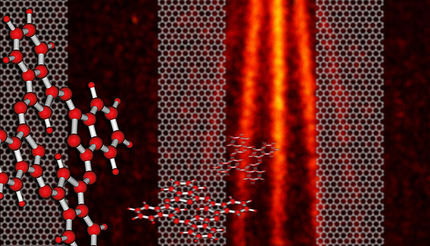Twisting neutrons
It's easy to contemplate the wave nature of light in common experience. White light passing through a prism spreads out into constituent colors; it diffracts from atmospheric moisture into a rainbow; light passing across a sharp edge or a diffraction grating creates an interference pattern. It's harder to fathom the wave behavior of things usually thought of as particles, such as electrons and atoms. And yet these matter waves play a role in physics and in technology. For example, electron beams, manifested as waves, provide an important form of microscopy.

This is a schematic phase plate for imparting extra quantum units of orbital angular momentum. Neutron waves fall on the face of this plate, made by milling a dowel of aluminum into a ramp-shaped spiral. The steeper the pitch of the milled phase plate, the more orbital angular momentum will be imparted to the neutron beam.
Ivar Taminiau
Neutrons, a basic constituent of atomic nuclei, have wave properties which are employed in a variety of research areas such as determining the structure of materials. A recent experiment provides a new handle for control of neutrons by demonstrating that a quantum variable called orbital angular momentum is accessible in beams of neutron waves, and that it can be manipulated for use in neutron imaging and quantum information processing.
This work was performed by a collaboration of scientists from the Institute of Quantum Computing (IQC: University of Waterloo, Canada), the Joint Quantum Institute (JQI), the National Institute of Standards and Technology (NIST), Boston University and the Perimeter Institute.
Orbital angular momentum
Angular momentum in physics is defined as the momentum of an object times its distance away from a center (a point or axis) around which the momentum operates. For example, the orbital angular momentum (OAM) of a planet going around the sun is the planet's momentum times its distance from the sun. Orbital angular momentum is also encountered in wave motions. In addition to their familiar motion as parallel wavefronts along one direction, waves can also corkscrew around their direction of propagation. The corkscrew or vortex orbital angular momentum (OAM) has been demonstrated previously for beams of light, x-rays, and electrons. The use of such beams is expected to be applied in the study of optical and x-ray microscopy, astronomy, the micromanipulation of particles, multiplexing/ de-multiplexing of waves with different OAM in a common communication channel, lithography, and the manipulation of quantum states.
Experimental Setup
To test these ideas with neutron waves, the researcher team performed interference experiments on neutrons produced by the nuclear reactor at the NIST Center for Neutron Research.
The orbital angular momentum of a neutron is expressed in the phase of its wavefunction. Thus, the value of the OAM can be changed by twisting the phase of the neutron wavefunction. This is accomplished using a counterintuitive property of neutrons: they travel faster through some materials than they do through a vacuum.
The twist in the neutron wavefunction is revealed in the pattern of interference of the two neutron paths, which are recombined at the third blade and sent towards two detectors. The neutron wave can be thought of as being spread out across the whole apparatus, until it enters the detectors. Then, the neutron is detected - in one detector or the other - by a destructive and violent process: it is absorbed by a nucleus, which splits into fragments whose energies are converted into optical and electrical signals. It is one of the remarkable features of quantum reality that even though neutron arrivals are recorded one by one, the looked-for characteristic pattern corresponding to neutron-wave interference within the apparatus should emerge by integrating the detected locations of many individual neutrons arriving over the week-long course of an experimental run. This position information is obtained by a two-dimensional (2D) detector. The observed pattern shows the characteristic shape one would expect for neutron waves with exactly the orbital angular momentum imposed by the phase plate.
Original publication
Other news from the department science

Get the chemical industry in your inbox
By submitting this form you agree that LUMITOS AG will send you the newsletter(s) selected above by email. Your data will not be passed on to third parties. Your data will be stored and processed in accordance with our data protection regulations. LUMITOS may contact you by email for the purpose of advertising or market and opinion surveys. You can revoke your consent at any time without giving reasons to LUMITOS AG, Ernst-Augustin-Str. 2, 12489 Berlin, Germany or by e-mail at revoke@lumitos.com with effect for the future. In addition, each email contains a link to unsubscribe from the corresponding newsletter.




























































